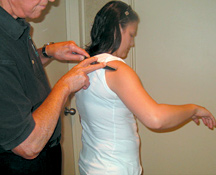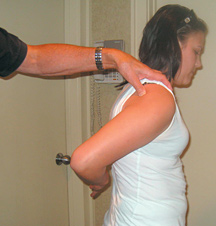Glenohumeral internal rotation deficit (GIRD) has been associated with shoulder internal and external impingement and tendinopathy. It is found in athletes (especially baseball pitchers) and also in nonathletic patients in adhesive capsulitis or just as a limited motion upsetting the normal mechanics of the shoulder.
Most of the manual techniques for the posterior capsule, such as Graston Technique (GT), ART and friction massage, to name just a few, treat the posterior capsule with the scapulohumeral joint at 90 degrees of abduction. In both ART and GT, many areas of treatment include motion and stretch. At present, most manual techniques are treating the posterior capsule with the shoulder abducted 90 degrees. Probably most of the capsule is being contacted. The addition of motion and/or stretch may increase results by accentuating the involved fibers. The point of the above study is that depending on the position of the shoulder, we can now determine the particular area of the capsule that is being stretched.
In the aforementioned study, they measured the strain (deformation) of the upper, middle and lower parts of the posterior capsule in positions of 0, 30, 60 and 90 degrees of elevation in thescapular plane; 60 degrees of flexion; 60 degrees of abduction; 30 degreesof extension, and 60 degrees of flexion and horizontal adduction. The authors concluded that the current positions of posterior capsule stretching, such as horizontal adduction or at 90 degrees abduction with internal rotation, were not sufficient to stretch the entire posterior capsule. They found large strains on the middle and lower capsule at the stretching position of 30 degrees of shoulder elevation in the scapular plane with internal rotation (Fig. 1), and for the upper and lower capsule, stretching at 30 degrees of extension with internal rotation (lift-off position) (Fig. 2).
 Fig. 1 Stretch position for middle & lower posterior capsule; 30-degree elevation in scapular plane.
Fig. 1 Stretch position for middle & lower posterior capsule; 30-degree elevation in scapular plane.
|
 Fig. 2 Stretch position for upper & lower posterior capsule; 30 degrees of extension with internal rotation for upper & lower capsule.
Fig. 2 Stretch position for upper & lower posterior capsule; 30 degrees of extension with internal rotation for upper & lower capsule.
|
In the first scenario, the patient could hold their elbow and move their shoulder from external to internal rotation with the arm elevated 30 degrees in the scapular plane, or they could hold this position internally rotated to the end-range while the practitioner treated the area. Either way, we are assured that we are treating the middle and lower capsule. Due to the extended position of the shoulder in the second scenario, it might be more difficult to exert pressure on the capsule since the deltoid muscle is compressed, but it can be done. I have already noticed that there has been a more rapid improvement in several patients using these positions. How about attempting these positions and e-mailing me your thoughts?
Reference
- Izumi T, Aoki M, Murky T, et al. Stretching positions for the posterior capsule of the glenohumeral joint. Am J Sports Med 2008;36:2014-22.
Click here for previous articles by Warren Hammer, MS, DC, DABCO.





